A Comprehensive Bioinformatic Analysis of RNA-seq Datasets Reveals a Differential and Variable Expression of Wildtype and Variant UGT1A Transcripts in Human Tissues and Their Deregulation in Cancers
Abstract
Simple Summary
Abstract
1. Introduction
2. Materials and Methods
2.1. Analysis of Differential and Variable Expression of Known UGT1A Transcripts in Normal Human Tissues and Their Deregulation in Cancers
2.2. Discovery and Quantification of Novel UGT1A Transcripts with 3′ Abnormalities
2.3. Statistical Analysis
3. Results
3.1. Expression Profiles of UGT1A Transcripts in Normal Human Tissues
3.2. Expression Profiles of UGT1A Transcripts in Normal Liver Tissues and Their Deregulation in Liver Tumor Tissues
3.3. Expression Profiles of UGT1A Transcripts in Normal Kidney Tissues and Their Deregulation in Kidney Tumor Tissues
3.4. Expression Profiles of UGT1A Transcripts in Normal Colorectal Tissues and Their Deregulation in Colorectal Cancer (CRC)
3.5. Expression Profiles of UGT1A Transcripts in Normal Stomach Tissues and Their Deregulation in Stomach Cancer
3.6. Expression Profiles of UGT1A Transcripts in Normal Esophagus Tissues and Their Deregulation in Esophagus Cancer
3.7. Expression Profiles of UGT1A Transcripts in Normal Bladder Tissues and Their Deregulation in Bladder Cancer
3.8. Discovery of Novel UGT1A Transcripts with 3′ Variant Splicing
4. Discussion
5. Conclusions
Supplementary Materials
Author Contributions
Funding
Institutional Review Board Statement
Informed Consent Statement
Data Availability Statement
Conflicts of Interest
References
- Mackenzie, P.I.; Bock, K.W.; Burchell, B.; Guillemette, C.; Ikushiro, S.; Iyanagi, T.; Miners, J.O.; Owens, I.S.; Nebert, D.W. Nomenclature update for the mammalian UDP glycosyltransferase (UGT) gene superfamily. Pharmacogenet. Genom. 2005, 15, 677–685. [Google Scholar] [CrossRef] [PubMed]
- Meech, R.; Hu, D.G.; McKinnon, R.A.; Mubarokah, S.N.; Haines, A.Z.; Nair, P.C.; Rowland, A.; Mackenzie, P.I. The UDP-Glycosyltransferase (UGT) Superfamily: New Members, New Functions, and Novel Paradigms. Physiol. Rev. 2019, 99, 1153–1222. [Google Scholar] [PubMed]
- Iyer, L.; King, C.D.; Whitington, P.F.; Green, M.D.; Roy, S.K.; Tephly, T.R.; Coffman, B.L.; Ratain, M.J. Genetic predisposition to the metabolism of irinotecan (CPT-11). Role of uridine diphosphate glucuronosyltransferase isoform 1A1 in the glucuronidation of its active metabolite (SN-38) in human liver microsomes. J. Clin. Investig. 1998, 101, 847–854. [Google Scholar] [CrossRef] [PubMed]
- Hanioka, N.; Ozawa, S.; Jinno, H.; Ando, M.; Saito, Y.; Sawada, J. Human liver UDP-glucuronosyltransferase isoforms involved in the glucuronidation of 7-ethyl-10-hydroxycamptothecin. Xenobiotica 2001, 31, 687–699. [Google Scholar] [CrossRef] [PubMed]
- Bosma, P.J.; Seppen, J.; Goldhoorn, B.; Bakker, C.; Oude Elferink, R.P.; Chowdhury, J.R.; Chowdhury, N.R.; Jansen, P.L. Bilirubin UDP-glucuronosyltransferase 1 is the only relevant bilirubin glucuronidating isoform in man. J. Biol. Chem. 1994, 269, 17960–17964. [Google Scholar] [PubMed]
- Abuduxikuer, K.; Fang, L.J.; Li, L.T.; Gong, J.Y.; Wang, J.S. UGT1A1 genotypes and unconjugated hyperbilirubinemia phenotypes in post-neonatal Chinese children: A retrospective analysis and quantitative correlation. Medicine (Baltimore) 2018, 97, e13576. [Google Scholar] [CrossRef]
- Iolascon, A.; Faienza, M.F.; Centra, M.; Storelli, S.; Zelante, L.; Savoia, A. (TA)8 allele in the UGT1A1 gene promoter of a Caucasian with Gilbert’s syndrome. Haematologica 1999, 84, 106–109. [Google Scholar]
- Kadakol, A.; Ghosh, S.S.; Sappal, B.S.; Sharma, G.; Chowdhury, J.R.; Chowdhury, N.R. Genetic lesions of bilirubin uridine-diphosphoglucuronate glucuronosyltransferase (UGT1A1) causing Crigler-Najjar and Gilbert syndromes: Correlation of genotype to phenotype. Hum. Mutat. 2000, 16, 297–306. [Google Scholar]
- Mi, X.X.; Yan, J.; Ma, X.J.; Zhu, G.L.; Gao, Y.D.; Yang, W.J.; Kong, X.W.; Chen, G.Y.; Shi, J.P.; Gong, L. Analysis of the UGT1A1 Genotype in Hyperbilirubinemia Patients: Differences in Allele Frequency and Distribution. Biomed. Res. Int. 2019, 2019, 6272174. [Google Scholar] [CrossRef]
- Rossi, F.; Francese, M.; Iodice, R.M.; Falcone, E.; Vetrella, S.; Punzo, F.; De Vita, S.; Perrotta, S. Inherited disorders of bilirubin metabolism. Minerva Pediatr. 2005, 57, 53–63. [Google Scholar]
- Di Paolo, A.; Bocci, G.; Polillo, M.; Del Re, M.; Di Desidero, T.; Lastella, M.; Danesi, R. Pharmacokinetic and pharmacogenetic predictive markers of irinotecan activity and toxicity. Curr. Drug Metab. 2011, 12, 932–943. [Google Scholar] [CrossRef] [PubMed]
- Hoskins, J.M.; Goldberg, R.M.; Qu, P.; Ibrahim, J.G.; McLeod, H.L. UGT1A1*28 genotype and irinotecan-induced neutropenia: Dose matters. J. Natl. Cancer Inst. 2007, 99, 1290–1295. [Google Scholar] [CrossRef] [PubMed]
- Liu, X.; Cheng, D.; Kuang, Q.; Liu, G.; Xu, W. Association between UGT1A1*28 polymorphisms and clinical outcomes of irinotecan-based chemotherapies in colorectal cancer: A meta-analysis in Caucasians. PLoS ONE 2013, 8, e58489. [Google Scholar]
- Takano, M.; Sugiyama, T. UGT1A1 polymorphisms in cancer: Impact on irinotecan treatment. Pharmgenom. Pers. Med. 2017, 10, 61–68. [Google Scholar] [CrossRef] [PubMed]
- Hu, D.G.; Mackenzie, P.I.; Hulin, J.A.; McKinnon, R.A.; Meech, R. Circular RNAs of UDP-Glycosyltransferase (UGT) Genes Expand the Complexity and Diversity of the UGT Transcriptome. Mol. Pharmacol. 2021, 99, 488–503. [Google Scholar] [CrossRef] [PubMed]
- Tourancheau, A.; Margaillan, G.; Rouleau, M.; Gilbert, I.; Villeneuve, L.; Levesque, E.; Droit, A.; Guillemette, C. Unravelling the transcriptomic landscape of the major phase II UDP-glucuronosyltransferase drug metabolizing pathway using targeted RNA sequencing. Pharmacogenom. J. 2016, 16, 60–70. [Google Scholar] [CrossRef] [PubMed][Green Version]
- Hu, D.G.; Hulin, J.A.; Nair, P.C.; Haines, A.Z.; McKinnon, R.A.; Mackenzie, P.I.; Meech, R. The UGTome: The expanding diversity of UDP glycosyltransferases and its impact on small molecule metabolism. Pharmacol. Ther. 2019, 204, 107414. [Google Scholar]
- Girard, H.; Levesque, E.; Bellemare, J.; Journault, K.; Caillier, B.; Guillemette, C. Genetic diversity at the UGT1 locus is amplified by a novel 3’ alternative splicing mechanism leading to nine additional UGT1A proteins that act as regulators of glucuronidation activity. Pharmacogenet. Genom. 2007, 17, 1077–1089. [Google Scholar] [CrossRef]
- Levesque, E.; Girard, H.; Journault, K.; Lepine, J.; Guillemette, C. Regulation of the UGT1A1 bilirubin-conjugating pathway: Role of a new splicing event at the UGT1A locus. Hepatology 2007, 45, 128–138. [Google Scholar] [CrossRef]
- Bellemare, J.; Rouleau, M.; Girard, H.; Harvey, M.; Guillemette, C. Alternatively spliced products of the UGT1A gene interact with the enzymatically active proteins to inhibit glucuronosyltransferase activity in vitro. Drug Metab. Dispos. 2010, 38, 1785–1789. [Google Scholar] [CrossRef]
- Bellemare, J.; Rouleau, M.; Harvey, M.; Guillemette, C. Modulation of the human glucuronosyltransferase UGT1A pathway by splice isoform polypeptides is mediated through protein-protein interactions. J. Biol. Chem. 2010, 285, 3600–3607. [Google Scholar] [CrossRef] [PubMed]
- Rouleau, M.; Collin, P.; Bellemare, J.; Harvey, M.; Guillemette, C. Protein-protein interactions between the bilirubin-conjugating UDP-glucuronosyltransferase UGT1A1 and its shorter isoform 2 regulatory partner derived from alternative splicing. Biochem. J. 2013, 450, 107–114. [Google Scholar] [CrossRef] [PubMed]
- Rouleau, M.; Tourancheau, A.; Girard-Bock, C.; Villeneuve, L.; Vaucher, J.; Duperre, A.M.; Audet-Delage, Y.; Gilbert, I.; Popa, I.; Droit, A.; et al. Divergent Expression and Metabolic Functions of Human Glucuronosyltransferases through Alternative Splicing. Cell Rep. 2016, 17, 114–124. [Google Scholar] [CrossRef] [PubMed]
- Rouleau, M.; Roberge, J.; Falardeau, S.A.; Villeneuve, L.; Guillemette, C. The relative protein abundance of UGT1A alternative splice variants as a key determinant of glucuronidation activity in vitro. Drug Metab. Dispos. 2013, 41, 694–697. [Google Scholar] [CrossRef]
- Audet-Delage, Y.; Rouleau, M.; Rouleau, M.; Roberge, J.; Miard, S.; Picard, F.; Tetu, B.; Guillemette, C. Cross-Talk between Alternatively Spliced UGT1A Isoforms and Colon Cancer Cell Metabolism. Mol. Pharmacol. 2017, 91, 167–177. [Google Scholar] [CrossRef] [PubMed]
- Rouleau, M.; Roberge, J.; Bellemare, J.; Guillemette, C. Dual roles for splice variants of the glucuronidation pathway as regulators of cellular metabolism. Mol. Pharmacol. 2014, 85, 29–36. [Google Scholar] [CrossRef]
- Jones, N.R.; Sun, D.; Freeman, W.M.; Lazarus, P. Quantification of Hepatic UDP glucuronosyltransferase 1A splice variant expression and correlation of UDP glucuronosyltransferase 1A1 variant expression with glucuronidation activity. J. Pharmacol. Exp. Ther. 2012, 342, 720–729. [Google Scholar] [CrossRef]
- Tourancheau, A.; Rouleau, M.; Guauque-Olarte, S.; Villeneuve, L.; Gilbert, I.; Droit, A.; Guillemette, C. Quantitative profiling of the UGT transcriptome in human drug-metabolizing tissues. Pharmacogenom. J. 2018, 18, 251–261. [Google Scholar] [CrossRef]
- Benoit-Biancamano, M.O.; Connelly, J.; Villeneuve, L.; Caron, P.; Guillemette, C. Deferiprone glucuronidation by human tissues and recombinant UDP glucuronosyltransferase 1A6: An in vitro investigation of genetic and splice variants. Drug Metab. Dispos. 2009, 37, 322–329. [Google Scholar] [CrossRef]
- Bellemare, J.; Rouleau, M.; Harvey, M.; Popa, I.; Pelletier, G.; Tetu, B.; Guillemette, C. Immunohistochemical expression of conjugating UGT1A-derived isoforms in normal and tumoral drug-metabolizing tissues in humans. J. Pathol. 2011, 223, 425–435. [Google Scholar] [CrossRef]
- Fagerberg, L.; Hallstrom, B.M.; Oksvold, P.; Kampf, C.; Djureinovic, D.; Odeberg, J.; Habuka, M.; Tahmasebpoor, S.; Danielsson, A.; Edlund, K.; et al. Analysis of the human tissue-specific expression by genome-wide integration of transcriptomics and antibody-based proteomics. Mol. Cell Proteom. 2014, 13, 397–406. [Google Scholar] [CrossRef] [PubMed]
- Long, M.; Zhou, Z.; Wei, X.; Lin, Q.; Qiu, M.; Zhou, Y.; Chen, P.; Jiang, Y.; Wen, Q.; Liu, Y.; et al. A novel risk score based on immune-related genes for hepatocellular carcinoma as a reliable prognostic biomarker and correlated with immune infiltration. Front. Immunol. 2022, 13, 1023349. [Google Scholar] [CrossRef] [PubMed]
- Wang, X.M.; Lu, Y.; Song, Y.M.; Dong, J.; Li, R.Y.; Wang, G.L.; Wang, X.; Zhang, S.D.; Dong, Z.H.; Lu, M.; et al. Integrative genomic study of Chinese clear cell renal cell carcinoma reveals features associated with thrombus. Nat. Commun. 2020, 11, 739. [Google Scholar] [CrossRef] [PubMed]
- Wu, S.M.; Tsai, W.S.; Chiang, S.F.; Lai, Y.H.; Ma, C.P.; Wang, J.H.; Lin, J.; Lu, P.S.; Yang, C.Y.; Tan, B.C.; et al. Comprehensive transcriptome profiling of Taiwanese colorectal cancer implicates an ethnic basis for pathogenesis. Sci. Rep. 2020, 10, 4526. [Google Scholar] [CrossRef] [PubMed]
- Mun, D.G.; Bhin, J.; Kim, S.; Kim, H.; Jung, J.H.; Jung, Y.; Jang, Y.E.; Park, J.M.; Kim, H.; Jung, Y.; et al. Proteogenomic Characterization of Human Early-Onset Gastric Cancer. Cancer Cell 2019, 35, 111–124.e10. [Google Scholar] [CrossRef]
- You, B.H.; Yoon, J.H.; Kang, H.; Lee, E.K.; Lee, S.K.; Nam, J.W. HERES, a lncRNA that regulates canonical and noncanonical Wnt signaling pathways via interaction with EZH2. Proc. Natl. Acad. Sci. USA 2019, 116, 24620–24629. [Google Scholar] [CrossRef]
- Chen, X.; Li, A.; Sun, B.F.; Yang, Y.; Han, Y.N.; Yuan, X.; Chen, R.X.; Wei, W.S.; Liu, Y.; Gao, C.C.; et al. 5-Methylcytosine promotes pathogenesis of bladder cancer through stabilizing mRNAs. Nat. Cell Biol. 2019, 21, 978–990. [Google Scholar] [CrossRef]
- Zhang, J.; Kobert, K.; Flouri, T.; Stamatakis, A. PEAR: A fast and accurate Illumina Paired-End reAd mergeR. Bioinformatics 2014, 30, 614–620. [Google Scholar] [CrossRef]
- Wen, B.; Zhang, B. PepQuery2 democratizes public MS proteomics data for rapid peptide searching. Nat. Commun. 2023, 14, 2213. [Google Scholar] [CrossRef]
- Bellemare, J.; Rouleau, M.; Harvey, M.; Tetu, B.; Guillemette, C. Alternative-splicing forms of the major phase II conjugating UGT1A gene negatively regulate glucuronidation in human carcinoma cell lines. Pharmacogenom. J. 2010, 10, 431–441. [Google Scholar] [CrossRef]
- Hu, D.G.; Mackenzie, P.I.; Hulin, J.A.; McKinnon, R.A.; Meech, R. Regulation of human UDP-glycosyltransferase (UGT) genes by miRNAs. Drug Metab. Rev. 2022, 54, 120–140. [Google Scholar] [CrossRef] [PubMed]

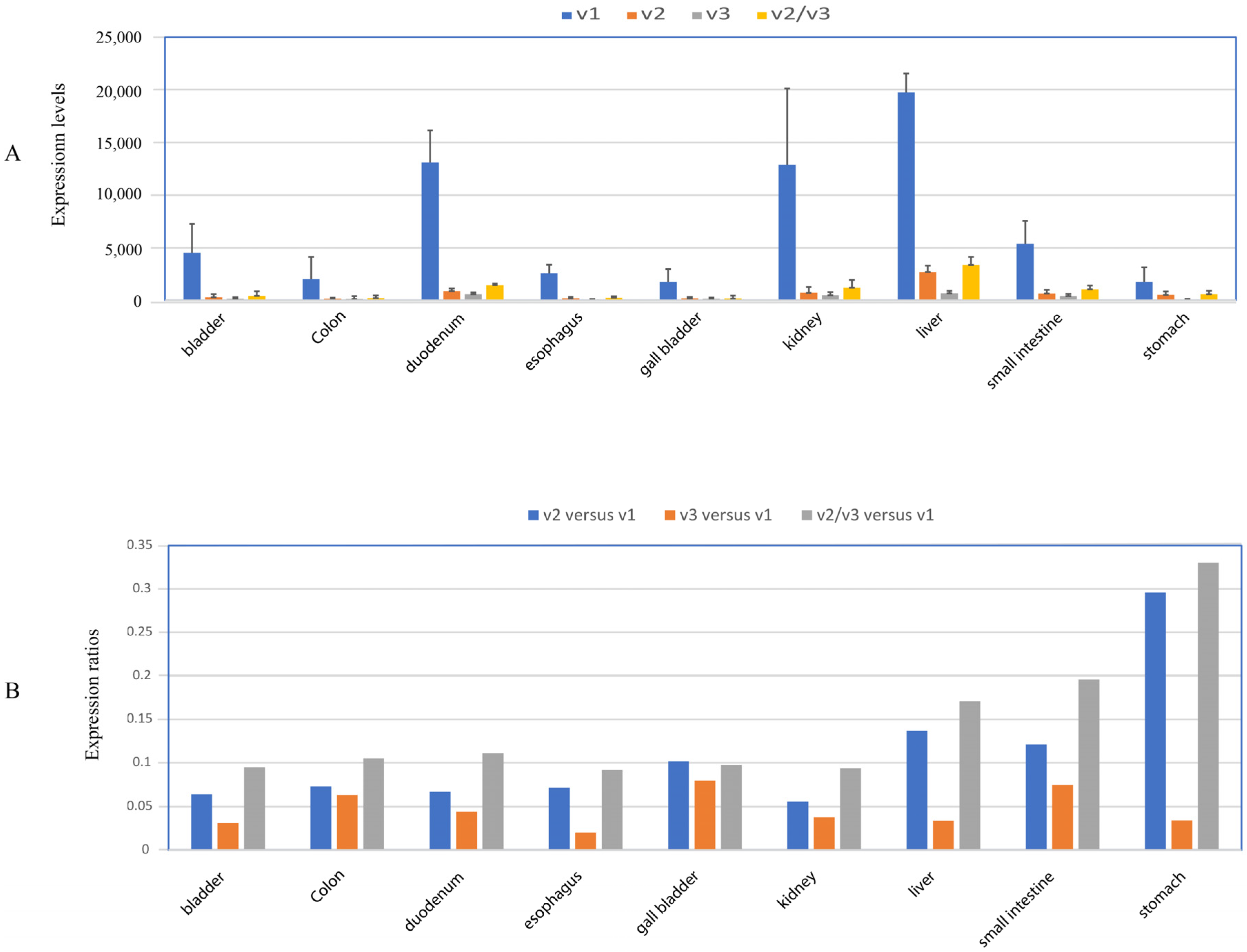

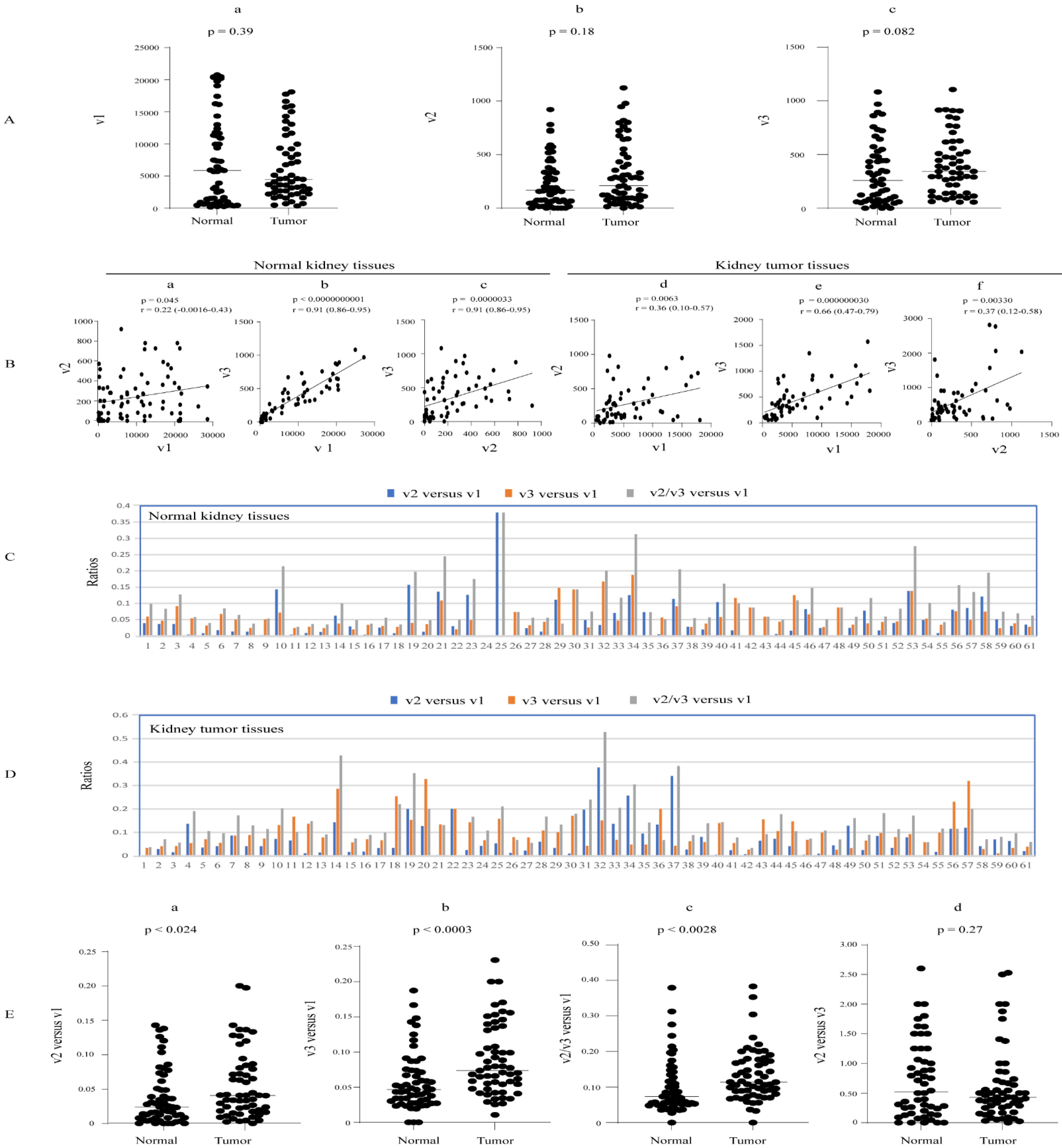
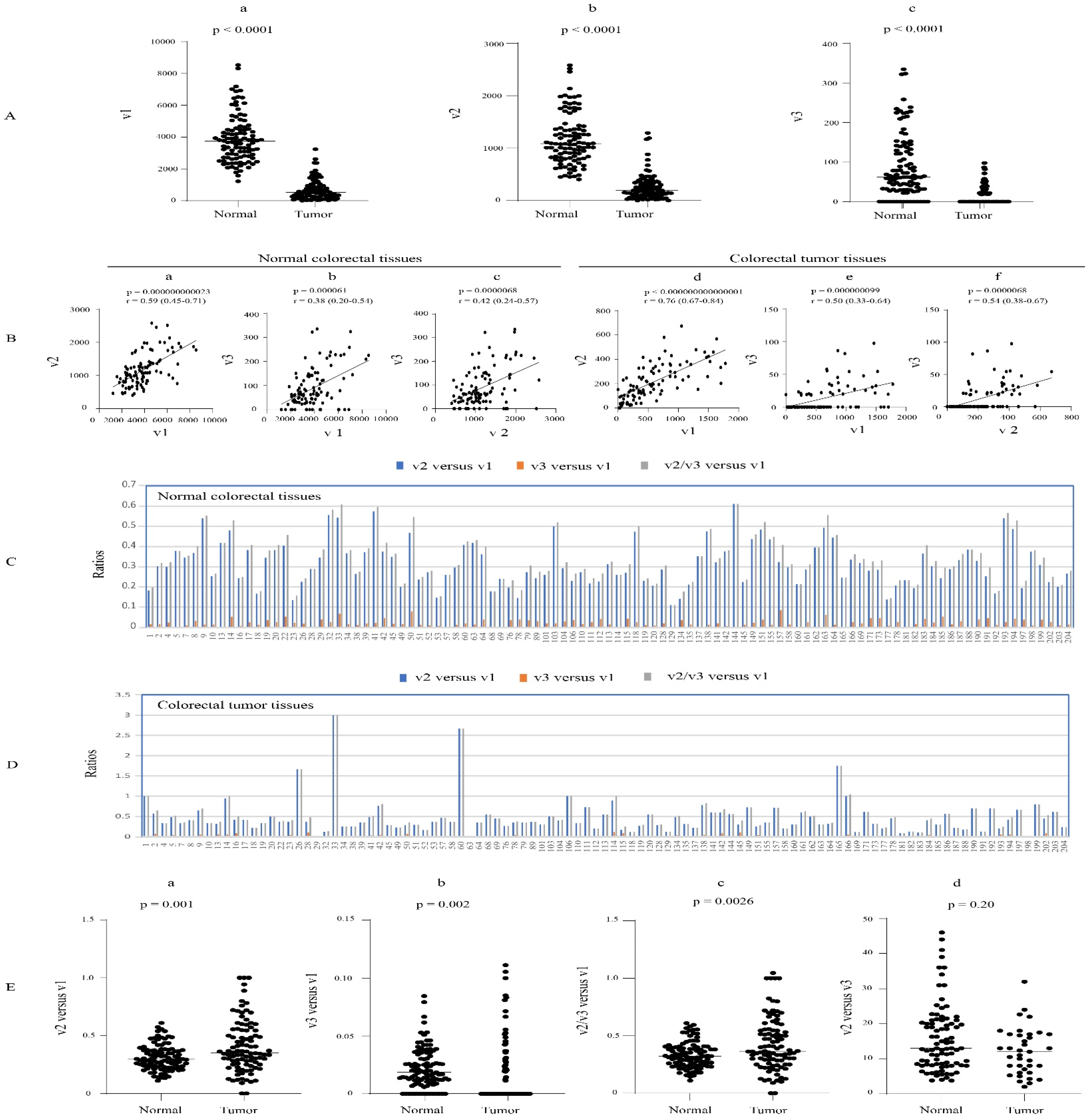
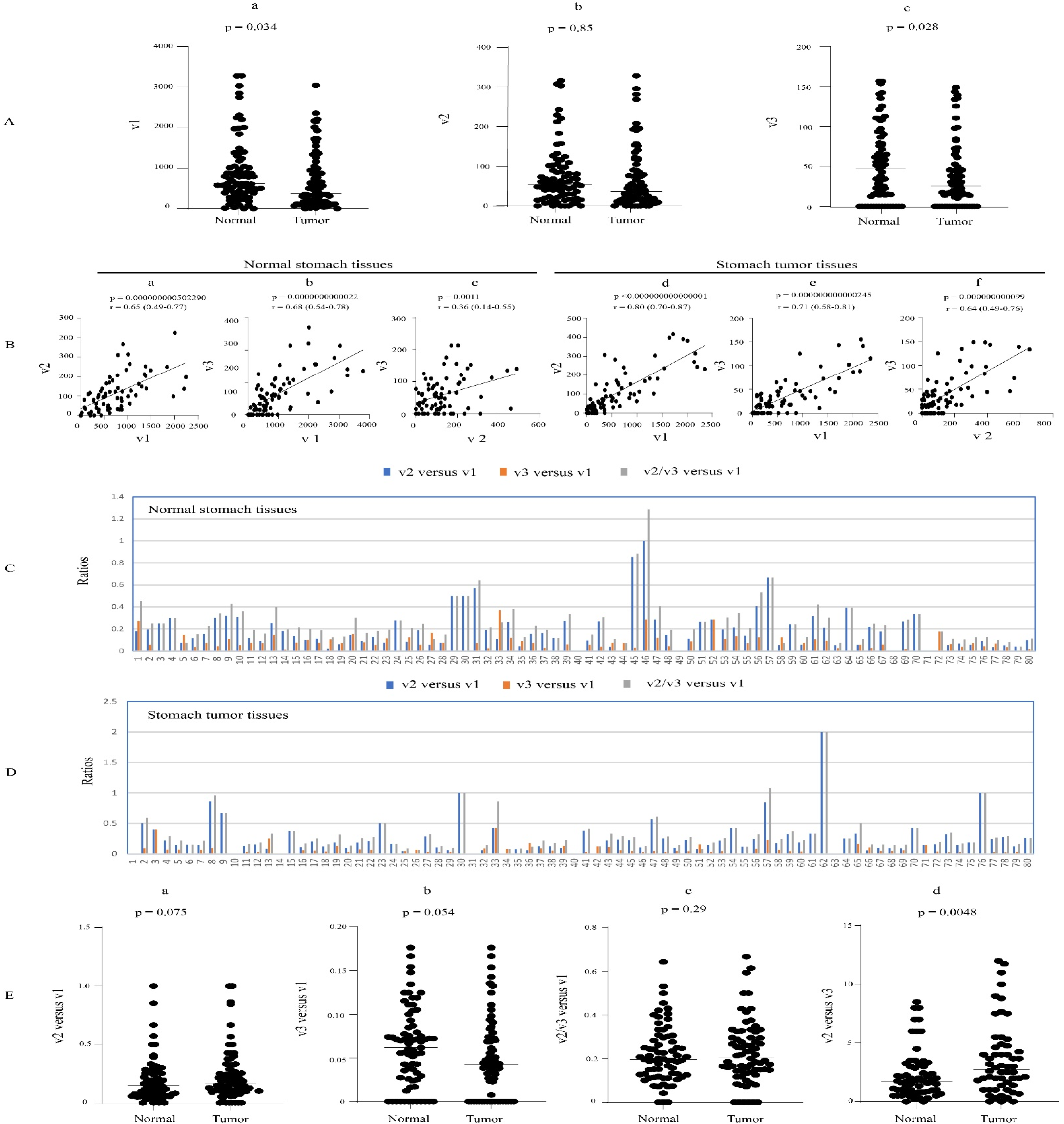
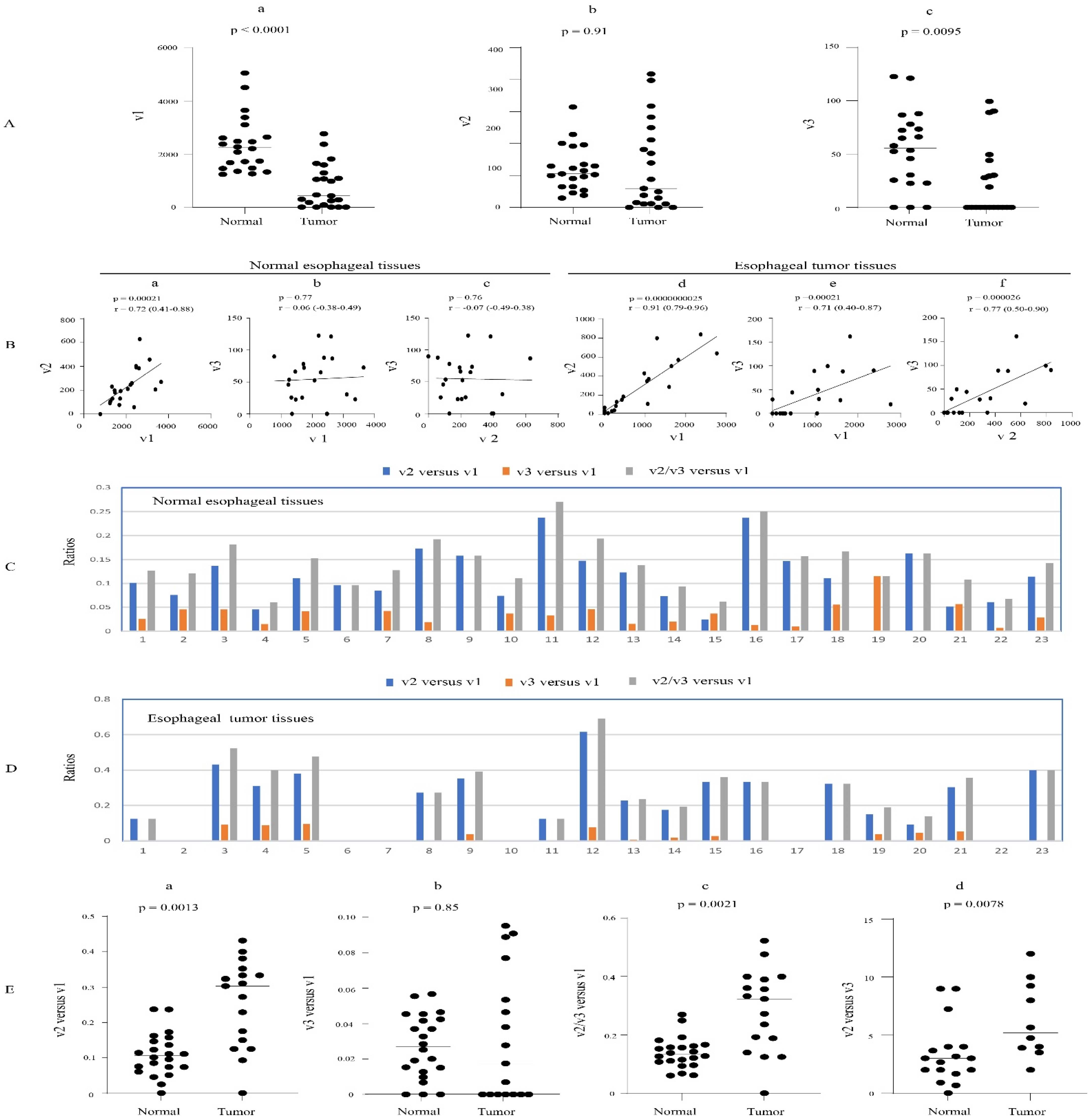
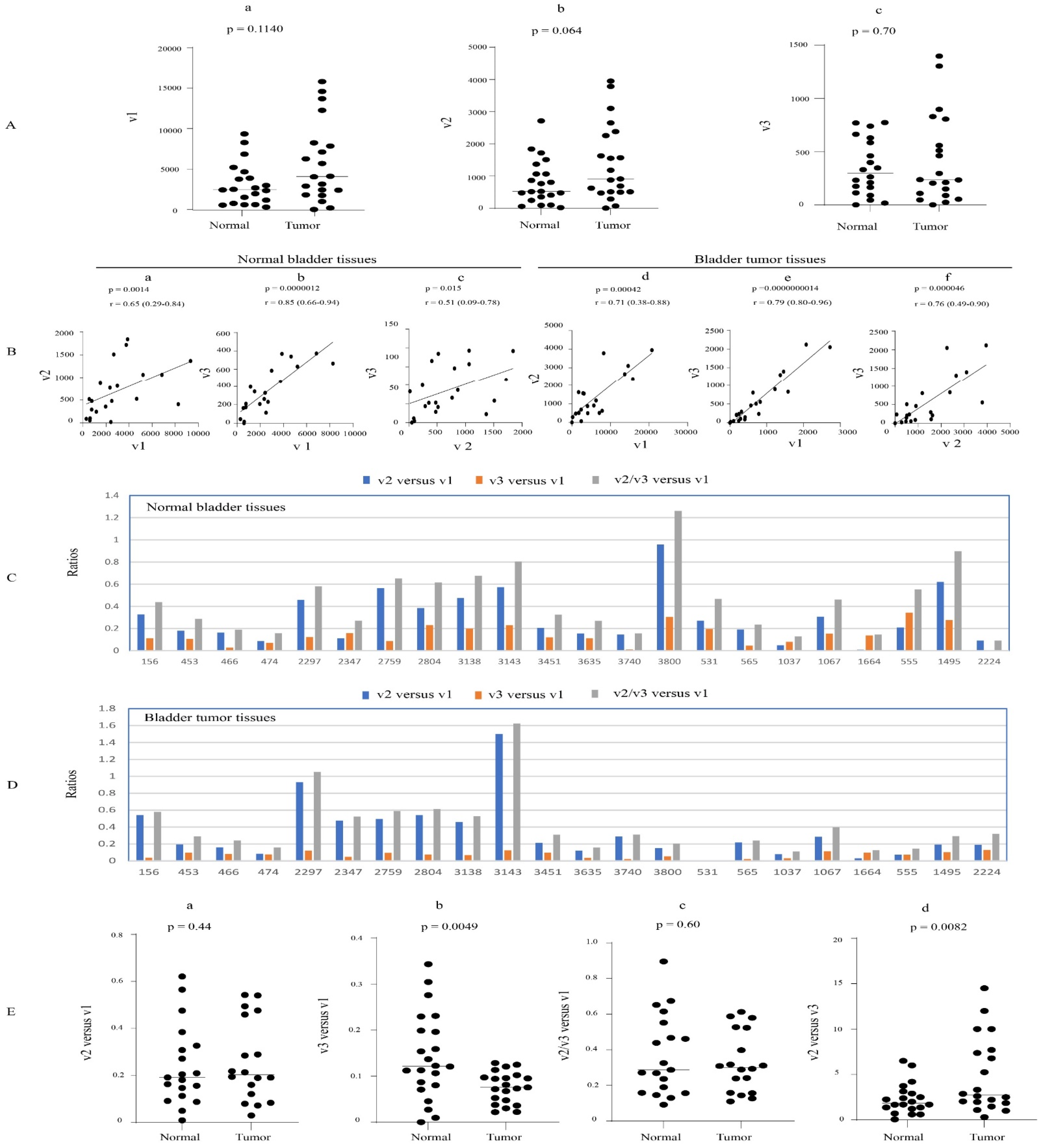
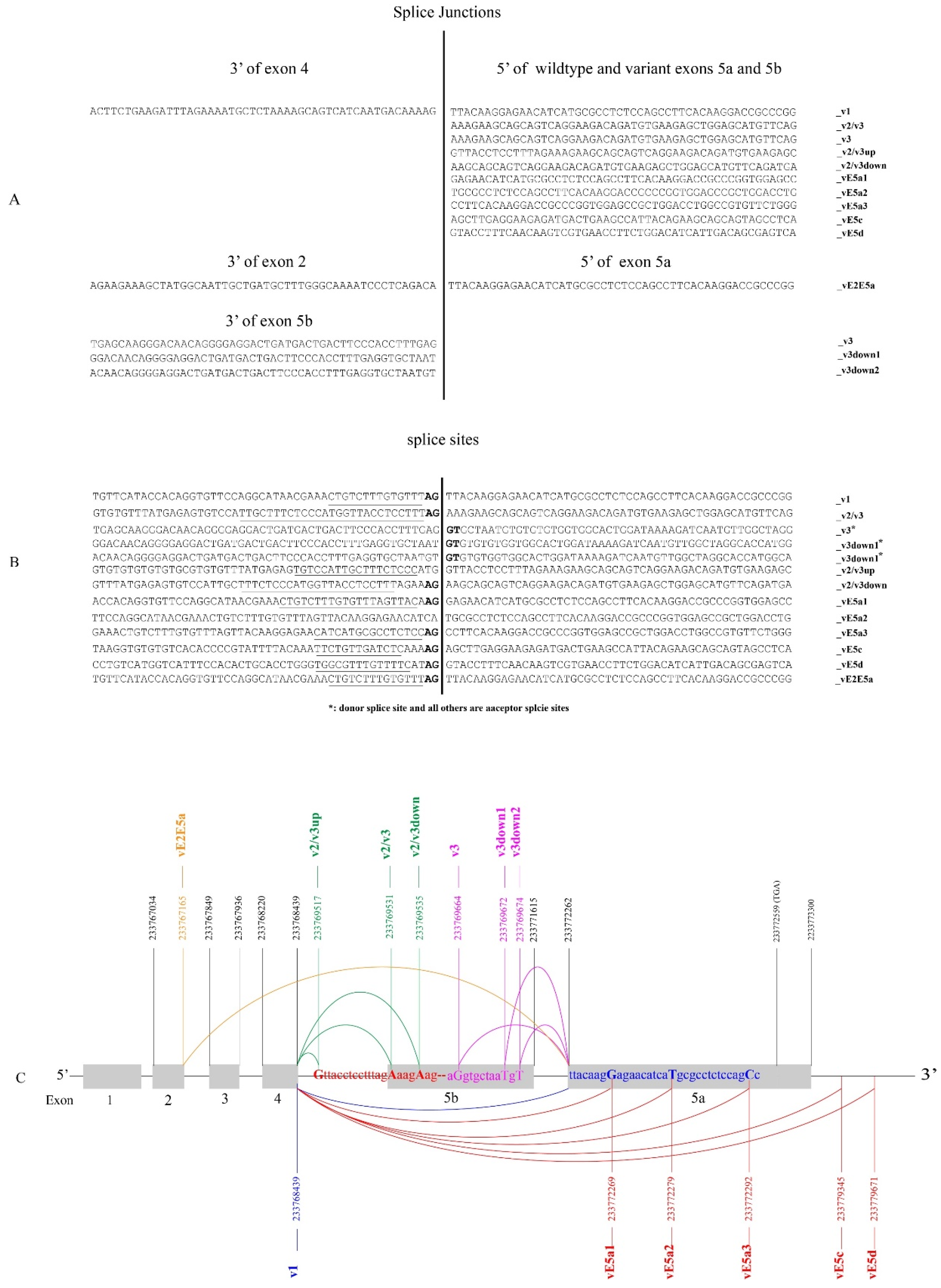
| RNA-seq Dataset | No. of Paired Tissues | Normal Tissues | Tumor Tissues | SRA Accession No. | ||||||||||
|---|---|---|---|---|---|---|---|---|---|---|---|---|---|---|
| v1 | v2 | v3 | v1 | v2 | v3 | |||||||||
| No. | Fold | No. | Fold | No. | Fold | No. | Fold | No. | Fold | No. | Fold | |||
| Liver cancer | 65 | 65 | 17 | 64 | 236 | 65 | 14 | 64 | 1697 | 63 | 454 | 61 | 138 | SRP401130 |
| Kidney cancer | 61 | 61 | 150 | 55 | 60 | 58 | 71 | 61 | 113 | 60 | 337 | 61 | 64 | SRP238334 |
| Colorectal cancer | 103 | 103 | 7.0 | 103 | 6.3 | 88 | 15 | 102 | 150 | 101 | 82 | 38 | 5.3 | SRP107326 |
| Stomach cancer | 80 | 78 | 369 | 74 | 62 | 64 | 21 | 72 | 62 | 78 | 64 | 58 | 14 | SRP172499 |
| Esophagus cancer | 23 | 23 | 6.5 | 22 | 18 | 20 | 13 | 18 | 101 | 20 | 60 | 12 | 18 | SRP193095 |
| Bladder cancer | 22 | 22 | 108 | 22 | 131 | 21 | 133 | 21 | 142 | 21 | 94 | 21 | 88 | SRP212702 |
Disclaimer/Publisher’s Note: The statements, opinions and data contained in all publications are solely those of the individual author(s) and contributor(s) and not of MDPI and/or the editor(s). MDPI and/or the editor(s) disclaim responsibility for any injury to people or property resulting from any ideas, methods, instructions or products referred to in the content. |
© 2024 by the authors. Licensee MDPI, Basel, Switzerland. This article is an open access article distributed under the terms and conditions of the Creative Commons Attribution (CC BY) license (https://creativecommons.org/licenses/by/4.0/).
Share and Cite
Hu, D.G.; Marri, S.; Hulin, J.-A.; McKinnon, R.A.; Mackenzie, P.I.; Meech, R. A Comprehensive Bioinformatic Analysis of RNA-seq Datasets Reveals a Differential and Variable Expression of Wildtype and Variant UGT1A Transcripts in Human Tissues and Their Deregulation in Cancers. Cancers 2024, 16, 353. https://doi.org/10.3390/cancers16020353
Hu DG, Marri S, Hulin J-A, McKinnon RA, Mackenzie PI, Meech R. A Comprehensive Bioinformatic Analysis of RNA-seq Datasets Reveals a Differential and Variable Expression of Wildtype and Variant UGT1A Transcripts in Human Tissues and Their Deregulation in Cancers. Cancers. 2024; 16(2):353. https://doi.org/10.3390/cancers16020353
Chicago/Turabian StyleHu, Dong Gui, Shashikanth Marri, Julie-Ann Hulin, Ross A. McKinnon, Peter I. Mackenzie, and Robyn Meech. 2024. "A Comprehensive Bioinformatic Analysis of RNA-seq Datasets Reveals a Differential and Variable Expression of Wildtype and Variant UGT1A Transcripts in Human Tissues and Their Deregulation in Cancers" Cancers 16, no. 2: 353. https://doi.org/10.3390/cancers16020353
APA StyleHu, D. G., Marri, S., Hulin, J.-A., McKinnon, R. A., Mackenzie, P. I., & Meech, R. (2024). A Comprehensive Bioinformatic Analysis of RNA-seq Datasets Reveals a Differential and Variable Expression of Wildtype and Variant UGT1A Transcripts in Human Tissues and Their Deregulation in Cancers. Cancers, 16(2), 353. https://doi.org/10.3390/cancers16020353






